冬のメカニカルキーボード:4つの小さなオプションがテストされた
さて、12月に入り、ここ古いイングランドでは気温が氷点下に近づき始めている。この寒さの中、私は室内でキーボードのレビューをすることにした。そう、私は本当にオタクなのだ。
それにもかかわらず、ここに3つの選択肢と楽しいワイルドカードを紹介する。真剣にカスタマイズ可能な65%の選択肢から、私のお気に入りのレイアウトといくつかの興味深い変更を加えた「ボード」、そして10年前の重要なカスタム・オプションを復活させたもう1つの65%の選択肢まで。
****
Well, we’re into the month of December, and temperatures are beginning to get close to freezing here in old England-land. What I’ve decided to do, in lieu of the cold weather, is take the time indoors to review some more keyboards, although this time with a focus on smaller choices that are rather interesting. Yes, I really am a nerd.
Nonetheless, here are three options and a fun wildcard for you to consider, ranging from a seriously customisable 65 percent choice to a ‘board with my favourite layout and some interesting changes and another 65 percent option which revives an important custom option from a decade ago.
Drop CSTM65 review: An SFF option with a hot-swappable case
ドロップ CSTM65レビュー: ホットスワップ対応ケースを備えたSFFオプション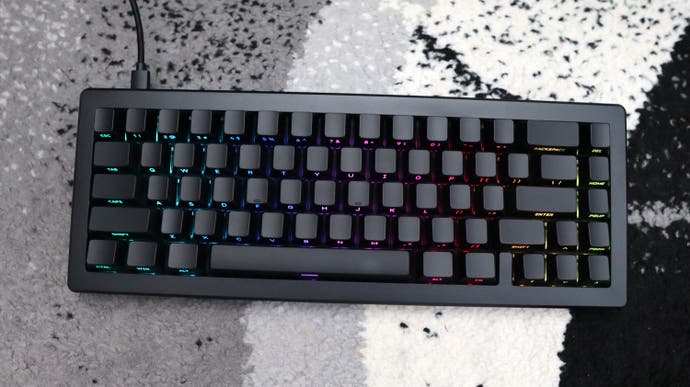
購入:
まず最初に紹介するのは、Drop CSTM65です。その名前は、この「ボード」が65%のカスタム仕様であることを説明しています。このボードは、より小さなフォームファクターレイアウトを採用し、より広いデスクスペースとトレンドを提供すると同時に、ホットスワップ可能なプラスチック製トップケースを備えています。その通り、CSTM65のトップ・ハウジングは、ケースを外して上に持ち上げるだけで、下のメタル・インナーを見せて交換することができる。私のサンプルでは、Dropはキーボードをブラックで送付し、数秒で交換可能なOvergrowthデコレーションケース($35)を提供してくれました。キーボードの見た目がガラリと変わるので、新しいキーボードに買い換えることなく、セットアップを新しくする独創的で費用対効果の高い方法だ。
また、この標準的な完全組み立て式モデルには、サイドプリントのABSキーキャップというファンキーな美的選択も用意されている。トップから下はブランクなので、少なくともタッチタイピングが得意でなければならないが、より標準的な凡例が配置された他のキーキャップに交換することもできる。これらはABSキーキャップなので、私が切望するPBTよりも安っぽい感触だが、それでも指の感覚は十分だ。
CSTM65の内部には、Gateron Yellow KS3リニアまたはGateron Brown Pro 3.0ソフトタクタイルスイッチが内蔵されている。私のサンプルには後者が付属していた。MXブラウンのクローンとしては妥当なものだが、触感はそれほど鮮明ではなく、またスイッチに潤滑剤が塗布されているため、感触が若干鈍くなるという残念な副作用もある。CSTM65はホットスワップ対応なので、3ピンや5ピンの他のスイッチにすぐに交換できる。

潤滑油の塗布されたスイッチ、ポリカーボ・ケースとインナー、CSTM65の内部にある様々な消音フォームにより、音響もしっかりしている。ケースのガタつきやピン音もなく、素晴らしいサウンドだ。RGBライティングは明るく、サイドプリントのキーキャップと相まって全体の美観を高めている。CSTM65は、QMKファームウェア・フラッシュとVIAの両方をサポートしており、Drop独自のオンライン・コンフィギュレーターでキーボードに直接ファームウェアをフラッシュすることができます。少し面倒ですが、パワフルなカスタマイズが可能です。
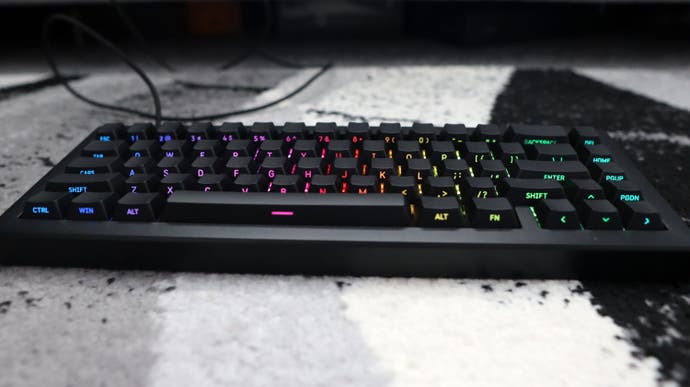
DropのCSTM65は、組み立て前の状態で129ドルとなっており、これだけのカスタマイズが可能なメカニカルキーボードとしては、かなりお買い得だ。CSTM65のようなモジュラリティを提供するキーボードは、それほど多くない。
***

Buy:
First up is the Drop CSTM65, whose name explains pretty much exactly what this ‘board is all about – a custom 65 percent choice. It offers the benefit of a smaller form factor layout for both providing more desk space and being on trend, while also coming with the fun of a hot-swappable plastic top case. That’s right – the CSTM65’s top housing can be replaced simply by taking the case off by lifting upwards to reveal the metal innards beneath. With my sample, Drop sent the keyboard in black, and provided the Overgrowth decorative case to go with it ($35) which can be swapped on in a matter of seconds. It completely changes the look of the keyboard, and is an ingenious and cost-effective way of giving your setup a new look without dropping a lot more on a new keyboard.
You also get funky aesthetic choices elsewhere on this standard, fully-assembled model with side-printed ABS keycaps. From the top down, they are blank, meaning you’ve got to be a competent touch-typist at least, although they can at least be swapped out for other keycaps with more standard legend placement if you’d prefer. These are ABS keycaps, so come with a cheaper feel than the PBT I crave, but nonetheless are decent enough under finger.
Connectivity here is purely wired via a USB-C to USB-A cable provided in the box, while inside the CSTM65 in pre-built form comes with either Gateron Yellow KS3 linear or Gateron Brown Pro 3.0 soft-tactile switches. My sample came with the latter. They’re a reasonable clone of MX Browns, although the tactility isn’t as crisp or present, and with the switches being lubricated, it has had the unfortunate side-effect of dampening the feeling a tad. With this in mind, they are comfortable switches to use for typing and the occasional piece of gaming, although if they aren’t what you’re after, you can soon change them to other switches with 3 or 5-pin mounting as the CSTM65 is hotswappable.
Acoustics here are also solid with the lubed switches, polycarb case and innards, and the range of sound-dampening foam that lives inside the CSTM65. There isn’t any case rattle or ping, and it sounds excellent. The RGB lighting on offer is bright, and with the side-printed keycaps, certainly adds to the overall aesthetic. It is addressable with the CSTM65 supporting both QMK firmware flashing and VIA, as Drop’s own online configurator where you can flash firmware choices directly to the keyboard. It is a little fiddly, but makes for powerful customisation.

In its prebuilt form, the Drop CSTM65 is going to run you $129, which for a mechanical choice with this much customisation, is rather decent value for money. Not many keyboards offer as much modularity as the CSTM65 without you paying a fair bit more, and if that’s what you’re after, this is an excellent keyboard.
WhiteFox Eclipseのレビュー: 10年前の最も重要なカスタムボードの1つを復活させる
購入:
WhiteFox Eclipseは、史上最も重要なキーボードについて語るとき、最初に思い浮かぶキーボードではないかもしれない。そのような議論は通常、IBMのModel FやMのために予約されている(そして通常、よくできたクローンの言及とともに持ち出される)。しかし、私はAlpaca Keyboards(Whitefox Eclipseの開発者)が主張するように、Matt3oのBrown Foxは最も重要なキーボードの一つだと思う。
WhiteFoxエクリプスは、メカニカル・キーボードのホビイスト・コミュニティのメンバー、すなわちDeskthorityのMatt3oが一から開発した最初のカスタム・キーボードの一つを現代に再現したものだ。Matt3oの名前は聞いたことがあるかもしれない。彼は以前、Drop/Massdropとコラボレートして様々なキーキャップを作っており、彼のデザインのいくつかは今でも在庫がある。2013年、彼は一からカスタムキーボードを作ることに着手し、レーザーカットされたアクリルケース、手作業によるはんだ付け、プレートマウントされたMXスイッチ(メインキーはMXブルー、矢印キーはMXレッド、スペースキーはMXグリーン)、アルミニウムプレート、そして美しいブラウンのキーキャップを選び、ブラウン・フォックスと命名した。
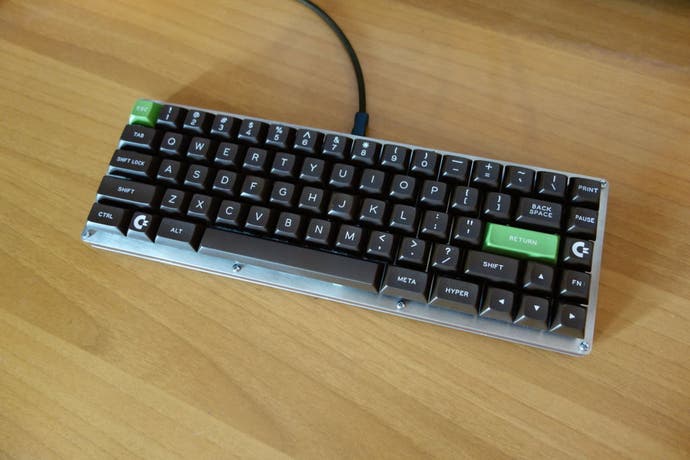
そこから、2015年にMassdropとInput Clubとのコラボレーションでいくつかの調整を加えて発売されたキーボードは、「White Fox」として知られ、当時Massdropで最も支持されたキーボードとなり、その後マニアに好まれるようになった65パーセントレイアウトの形を普及させた。興味深いのはその数年後で、新しいWhitefox EclipseのメーカーであるAlpacaは、Massdropのメカニカルキーボード・チームの元メンバーによって設立された。数年の開発期間を経て、WhiteFox Eclipseが市場に投入された。
Massdropの旧モデルWhiteFoxと今回の新モデルEclipseの類似点は、ほとんど外見的なもので、同じクリーンなホワイト仕上げ、右側にナビクラスターと矢印キーがある同様の「TrueFox」68%レイアウト、同じCherryプロファイル・ダイサブPBTキーキャップが採用されている。その結果、ゴージャスで素晴らしくモダンなキーボードに仕上がっている。
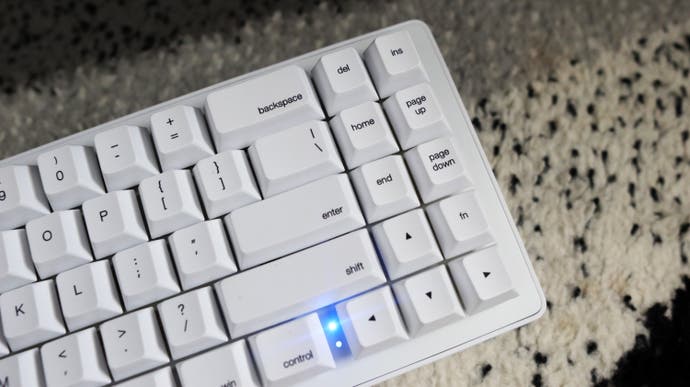
私のサンプルはプラスチックケースバージョンだが、Massdropバージョンと同じようにアルミケース付きもある。圧力がかかると多少たわみますが、それなりに頑丈です。デフォルトでは、WhiteFox Eclipseは背が高く平らなキーボードで、ケースはかなり厚く、フルサイズのスイッチが付属している。つまり、快適な角度に持ち上げないと使いにくいのだ。そのため、箱に入っているマグネット式の足が特にありがたい。
旧バージョンのMassdropでは、WhiteFox内のスイッチの選択肢が非常に多かった。全部で11種類あり、当時Massdropのユーザーの間で最も人気があったものから選ぶことができた。Cherry MX Red、Blue、Brownのような標準的なものから、Gateronクローンのもの、MX Green、Clear、Whiteのような現在でも珍しいMXのラインナップもありました。また、Gateron GreenとClearのオプションや、Zealiosスイッチもあり、これはGateronのソフトタクティルスイッチで、MX Clearsと同様の力、より高いアクチュエーションポイント、よりスムーズなアクチュエーションを提供する。
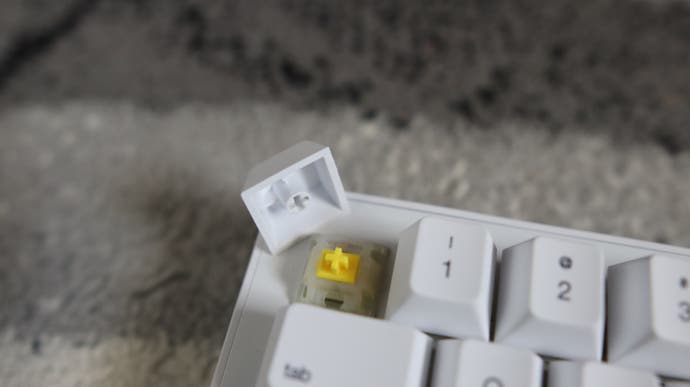
エクリプス・バージョンでは、よりシンプルになった。このキーボードには、あらかじめ潤滑剤が塗布されたガテロンイエローが内蔵されており、50gのリニアスイッチで、指の感触が特に滑らかだ。今までのガテロンとは違い、安定した反応の良い打鍵感で、記事などで多くの文字を入力する際に優れた打鍵感を感じた。また、ケース内には多くのポロンフォームが使われており、その潤滑性によって素晴らしい音響効果を実現している。これらのスイッチがお好みに合わない場合、WhiteFox Eclipseはホットスワップが可能です。これは、Massdropのオプションに対するこの新しいバージョンの利点の1つだ。
また、このキーボードはガスケットマウントを採用している。これは最近、多くの組み立て済みメカニカルキーボードの標準機能となっており、タイピングの感触は他のオプションに比べてやや弾力があり、明らかに反応が良い。これはエクリプスに有利に働き、あらゆる面で快適な体験を提供してくれる。
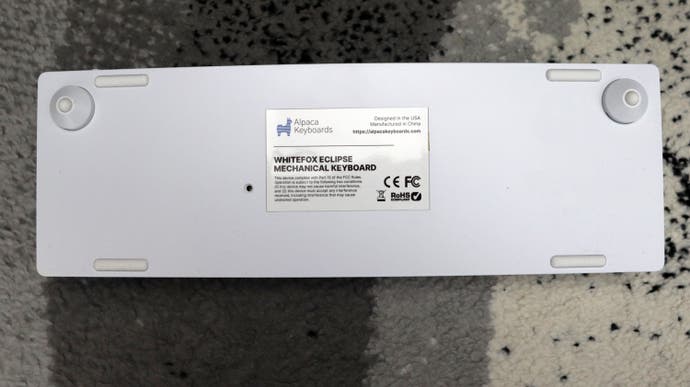
接続は最大3台までのBluetooth接続で、各チャンネルのペアリングはそれぞれFnキーとQ、W、Eキーを押しながら行う。WhiteFox EclipseはWindowsとmacOSの両方でうまく動作し、私のテストではどちらのOSでも問題なく動作した。macOSで使用するために、オリジナルに忠実なブルー・カラーとFoxアクセント・キー、キーキャップとスイッチ・プーラー、キーボード内部にアクセスするための両端スパッジャー、素晴らしい品質の編組USB-C-USB-A充電ケーブルとともに、Mac専用のキーキャップも同梱されている。
Alpacaは、WhiteFox Eclipseの4000mAhバッテリーの充電持続時間を約90時間と評価している。これは全体的にかなりしっかりしたもので、再び充電する必要があるまでに2、3週間は使えることを意味する。この90時間の駆動時間は、RGBライティングをオンにした状態でのものだ。オフにすれば、10日間使用できる。
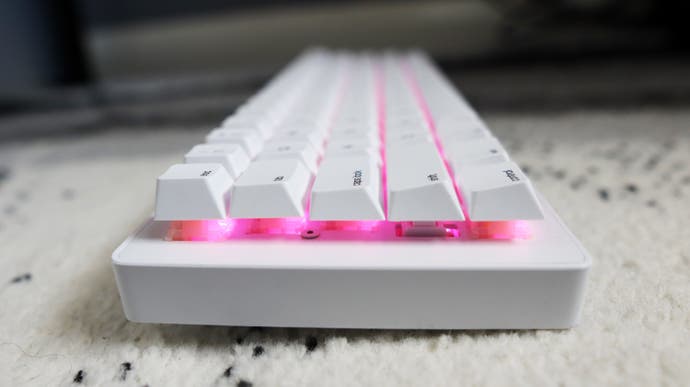
追加のソフトウェアはなく、カスタマイズは一連のキーボードショートカットでRGBライティングモードを変更する程度だ。赤と白、または青の異なる色合いだけを表示するものもあるが、ほとんどのものは虹の色を少しずつ異なるパターンで表示する。FnとMでパターンを変更でき、FnとKでパターンの色を切り替えることができる。実際のソフトウェアのように簡単にアクセスすることはできませんが、これらの設定には単色のバックライトが含まれています。
WhiteFox Alpacaは、過去10年間で最も重要なカスタムキーボードの1つに現代的な機能的タッチを追加した、オリジナルの選択肢の興味深い後継製品だ。オリジナル・バージョンのリリース以来、市場はかなり変化しているかもしれないが、この生まれ変わったバージョンが2024年の現在でも健在であることは間違いない。
WhiteFox Eclipse review: Reviving one of the most important custom ‘boards from a decade ago
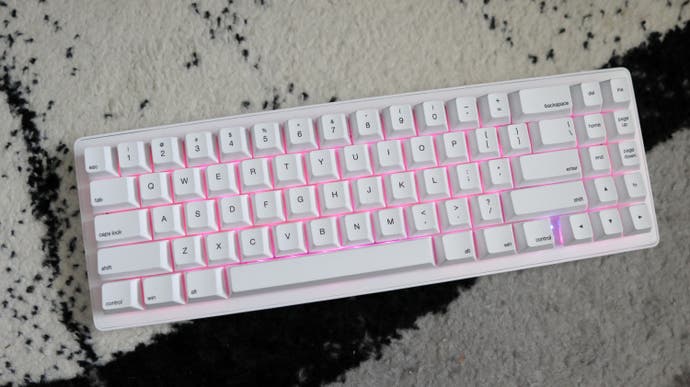
Buy:
The WhiteFox Eclipse may not be the first keyboard that comes to mind when it comes to talking about some of the most important keyboards of all time. That discussion is usually reserved for the IBM Model F or M (and usually brought up with its mention of well-made clones). However, I’d argue, as Alpaca Keyboards (the folks behind the Whitefox Eclipse) would, that Matt3o’s Brown Fox is one of the most.
Allow me to explain – the WhiteFox Eclipse is a modern reproduction of one of the first custom keyboards developed from the ground up from a member of the mechanical keyboard hobbyist community – namely Matt3o on Deskthority. You might have heard of Matt3o before – he used to collaborate with Drop/Massdrop on a range of keycaps, with some of his designs still stocked. Back in 2013, he set out to build a custom keyboard from the ground up, opting to go for an laser cut acrylic case; hand-soldered, plate mounted MX switches (MX Blues for the main keys, MX Red for arrow keys and MX Green for the space bar) aluminium plate and some lovely brown keycaps, christening it the Brown Fox.

From there, the keyboard was launched in collaboration with Massdrop and Input Club in 2015 with some tweaks, known as the White Fox, which became the most-backed keyboard on Massdrop at the time, and popularised a form of the 65 percent layout that has since become a favourite for enthusiasts. The interesting part comes a couple of years later when Alpaca, the makers of the new Whitefox Eclipse, was established by former members of Massdrop’s mechanical keyboards team, who then set out to make a new version of the Whitefox keyboard. After a few years of development, the WhiteFox Eclipse was brought to market.
The similarities between the old WhiteFox from Massdrop and the new Eclipse model here are mostly cosmetic, with the same clean white finish, a similar ‘TrueFox’ 68 percent layout with a nav cluster and arrow keys on the right hand side, and the same Cherry profile dye-sub PBT keycaps. It results in a keyboard that looks gorgeous and wonderfully modern.

My sample is the plastic case version, although you can also get it with an aluminium case, much like the Massdrop version. It’s reasonably sturdy, although comes with some flex under pressure. By default, the WhiteFox Eclipse is a tall and flat keyboard with the case being quite thick and with it coming with full-size switches. This means it can be quite difficult to use without it being raised up to a more comfortable angle. To this end, I’m especially grateful for the magnetic feet that are provided in the box.
On the older Massdrop version, you got a serious amount of choice with the switches inside the WhiteFox. In total, there were 11 to pick from with a range which were the most popular among users of Massdrop at the time. You had a choice of more standard options such as Cherry MX Red, Blue, and Brown, alongside their Gateron clone counterparts, as well as odder options from the MX lineup that are rare even now – MX Green, Clear and White. You also got Gateron Green and Clear options, as well as Zealios switches, which were Gateron soft tactile switches that offered a similar force to MX Clears, a higher actuation point, and a supposedly even smoother actuation.

With the Eclipse version here, things are a lot simpler. This keyboard comes with pre-lubed Gateron Yellows inside, which are a 50g linear switch that feel especially smooth under finger. Unlike other Gateron choices in the past, these have a consistent, responsive keypress which felt excellent to use when typing up plenty of words in articles and such. Their lubrication also allowed for fantastic acoustics alongside the presence of a lot of poron foam inside the case for dampening. If these switches aren’t to your liking though, the WhiteFox Eclipse is hot-swappable. That’s one benefit of this newer version against the Massdrop option.
This keyboard is also gasket-mounted, which has become a standard feature on a lot of prebuilt mechanical choices these days, lending the typing feel to have a slightly bouncier and perceivably more responsive feel against other options. It works in the Eclipse’s favour, offering a comfortable experience, all things considered.
Connectivity is handled by Bluetooth connectivity on up to 3 devices, with pairing on each channel handled by holding down the Fn and Q, W or E keys respectively. The WhiteFox Eclipse also plays nicely on both Windows and macOS and worked without an issue on both OSes in my testing. For macOS use, there are also Mac-specific keycaps included in the box, alongside blue-coloured and Fox accent keys to stay true to the original, a keycap and switch puller, a double-ended spudger for accessing the keyboard’s innards and a fantastic quality braided USB-C to USB-A charging cable.
Alpaca rates the WhiteFox Eclipse’s 4000mAh battery to last for around 90 hours on a charge. This is pretty solid overall, and means you’ll be able to go for a good couple of weeks before needing to charge it back up again. That 90 hour runtime is also with the RGB lighting on, which is great. Turn it off, and this extends all way to 10 days.
There isn’t any additional software here, with customisation limited to changing the RGB lighting mode through a series of keyboard shortcuts. There are a range to choose from, with most of them displaying colours of the rainbow in a slightly different patterns, although some only do this in red and white, or a different shade of blue. You can use Fn and M to change the pattern, and Fn and K to cycle through different colours for the pattern. There is single colour backlighting contained within these settings, although isn’t as easy to access as with actual software.
The WhiteFox Alpaca is an interesting successor to the original choice, adding some modern functional touches to one of the most important custom keyboards of the last decade. The market may have shifted a fair bit since the original version’s release, but there’s no doubt that this reimagined version still holds up in 2024.
HHKB Studioレビュー: 伝説の日本製キーボードが、すべてを変えて帰ってきた
購入:
私はこの1年半、お気に入りのスモール・フォーム・ファクター・キーボードのひとつであるHHKB Professional Hybrid Type-Sを使ったり使わなかったりしてきた。HHKBは、他にはない静電容量式スイッチとその奇妙なレイアウトで知られる、高価な日本のカルト的人気製品だ。HHKB Studioは、PFUコーポレーションが通常のメカニカル・キーボード愛好家向けにファースト・パーティのHHKBを提供する試みである。
この新しいStudioモデルには、通常のモデルと大きく異なる点が2つある。クラシックな東プレの静電容量式スイッチとは対照的に、StudioはKalih製の静音リニアスイッチを採用しており、45gの作動力がある。このリニアスイッチの打鍵感は驚くほどスムーズで、日常的な作業には十分な手応えを感じた。HHKB Studioのようなリニアでは得られない独特の触感があるため、キー入力がよりサクサクできるのだが、Kalihのスイッチは超静音でありながら、オフィスワークには最適だと感じた。
通常のHHKBとのもう一つの大きな違いは、英数字キーの真ん中にトラックポイントが追加されていることだ。トラックポイントは、1990年代から今日に至るまで、IBMやレノボのThinkPad、そしてその時代の他のノートパソコンに搭載されていることで知られている。1997年にレノボが特許を取得した技術だが、特許が失効したため、HHKB Studioなど他の製品にも採用されている。要するに、マウスを使わずにマウスカーソルを動かす方法を提供するポインティングスティックだ。
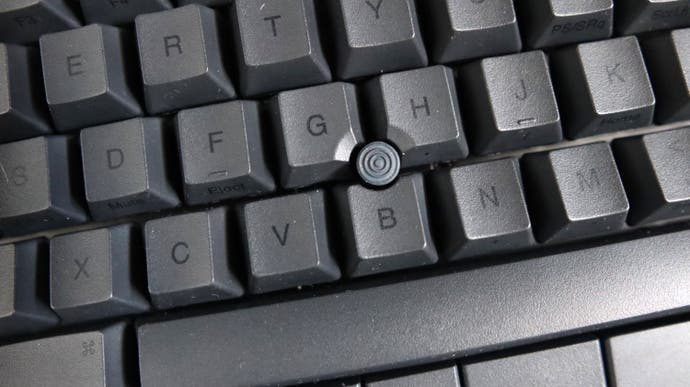
慣れるには少し時間がかかり、正確に操作する必要がありますが、トラックポイントは HHKB Studio の武器に追加するとかなり便利です。 Studio の下部には、スクロールなどのタスクを容易にするジェスチャ パッドがあり、スペース バーの下には左、中、右クリック用の専用マウス ボタンもあります。これは興味深い追加機能で、私自身かなりの量を使用していることに気付きました。確かに、思っていた以上に使用していました。
HHKB Studio には、トラックポイントに加えて、いくつかの興味深いジェスチャー パッドもバンドルされており、ボリュームの増減や Web ページのスクロールなどのコマンドにボードのシャーシの側面を使用できるようになります。これは興味深い追加機能ですが、従来の回転ダイヤルと比較すると見慣れないため、あまり使用することはできませんでした。
HHKB レイアウトは少し奇妙に見えるため、次に進む直前に議論する価値があります。これはすべて、日本のコンピュータ科学者である和田英一氏と、HHKB を製造する日本の企業である PFU Corporation とのコラボレーションのおかげです。和田氏は、1990 年代半ばに使用していたさまざまなオペレーティング システムやコンピュータで動作するレイアウトを望んでいました。その結果、Ctrl + C や Ctrl + V などの一般的な機能を実行するために指が移動する距離を減らすために Ctrl キーを通常 Caps Lock がある場所に移動したり、両方を押しやすくするために Backspace と Enter の間のキーを削除したり、ファンクション キーを従来のキーボードの配置の上の行に移動したりするなど、小さいながらも価値のある変更を加えた非常に快適なレイアウトが完成しました。
***
HHKB Studio review: The legendary Japanese keyboard returns, although with a different everything
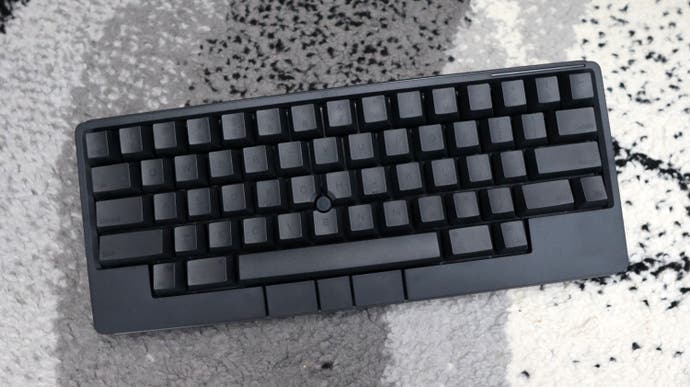
Buy:
I’ve been using an HHKB Professional Hybrid Type-S, which is one of our favourite small form factor keyboards, on and off for the last 18 months. On its own, the HHKB is an expensive Japanese cult sensation known for its electro-capacitive switches which are unlike anything else, and its odd layout. The HHKB Studio is the PFU Corporation’s attempt to offer a first-party HHKB for the more normal mechanical keyboard enthuisast – allow me to explain.
There are two big differences with this new Studio model against the normal models, the first of which is its choice of switches. As opposed to opting for the classic Topre electro-capacitive options inside, the Studio uses silent linear switches from Kalih with a 45g actuation force. They were surprisingly smooth to type on and felt responsive for day-to-day working, although I still prefer electro-capacitives in my normal HHKB. They just have a crisper keypress because of their unique tactility that you miss out on with linears such as in the HHKB Studio, but the Kalih switches inside felt excellent for office work while also being super quiet.
The other big difference against the normal HHKB is the addition of a trackpoint slap bang in the middle of the alphanumeric keys. The trackpoint is recognisable for being in the sea of IBM and Lenovo ThinkPads across from the 1990s to today, as well as other laptops from that era. It was a patented tech by Lenovo in 1997, although with its expiry, it has made its way into other products, such as the HHKB Studio. In essence, it is a pointing stick that offers a way of moving your mouse cursor without the need for a mouse.
It takes some getting used to, and you do have to be precise with it, but the trackpoint is a reasonably useful addition to the HHKB Studio’s arsenal. There are also gesture pads around the bottom of the Studio for making tasks such as scrolling easier, as well as dedicated mouse buttons below the space bar for left, middle and right click. That’s an interesting addition, and one I did find myself using a fair bit – more than I thought I would, admittedly.
Along with the trackpoint, the HHKB Studio also bundles in some interesting gesture pads, which allow you to use the sides of the board’s chassis for commands such as increasing and decreasing volume, or scrolling through a web page. It’s an interesting addition here, although not one I found myself using too much due to its unfamiliarity compared to a traditional rotary dial.
It’s worth discussing the HHKB layout just before I move on, as it looks a bit weird. It’s all thanks to a collaboration between Japanese computer scientist Eiiti Wada and the PFU Corporation, the Japanese firm that makes the HHKB. Wada wanted a layout that would work with the range of different operating systems and computers he used in the mid 1990s. What resulted is a very comfortable layout with some small, but worthwhile modifications, such as moving the Ctrl key to where Caps Lock would normally be to reduce the distance your fingers need to travel for performing common functions such as Ctrl+C and Ctrl+V, removing the key between Backspace and Enter to make it easier to hit both of them, and moving the Function key to a row above its placement on a traditional keyboard.
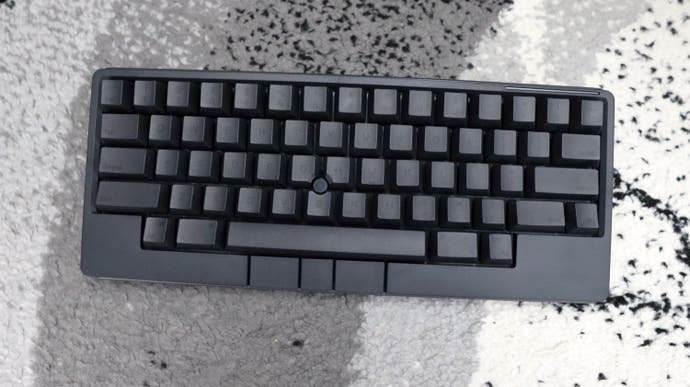
The HHKB Studio also works without a hitch on Windows and macOS, although comes with macOS keycaps by default – as an aside, the dye-sub PBT keycaps here are some of the best I’ve used. There is multi-point Bluetooth with it being able to connect to up to four devices at once, with pairing a breeze thanks to a key combo. There isn’t any USB receiver action here though, although having Bluetooth is arguably easier. I certainly had no trouble.
Software comes in the form of the HHKB Studio Keymap too, which allows you to remap keys, as well as add functions to dedicated keys, such as enabling the gesture pads’ functionality with a modifier key. In addition, there are also several function layers to program keys on to provide a fair amount of flexibility. It may not be as powerful as VIA, but the software is quite useful. The only issue is that it has to be used when the HHKB Studio is plugged in, which has you reaching for the cable if you want to remap any keys.
Then there’s the price – you might want to make sure you’re sitting up for this. The HHKB Studio is yours for £325/$329, which is hilariously expensive for a niche keyboard. It’s only something I’d recommend if it’s what you’re really after. Personally, I like the HHKB Studio, but then I am kind of the target market. For everyone else, if you want the HHKB experience in layout only with more customisation choices, this is great, but for everyone else, get a more ‘standard’ HHKB. You’ll thank me later.
ワイルドカード: NCR-80 R2 レビュー: レトロな感性を備えた DIY キーボード キット
買う:
スモール フォーム ファクター キーボードに関する上記の 3 つの選択肢よりもさらにニッチなものを検討したい場合は、通常、これらのまとめにワイルドカード、または奇妙な選択肢を含めます。 NCR-80 R2をご紹介させていただきます。
それ自体は、PCB、スタビライザー、ケースを備えたベアボーン形式で購入できる TKL メカニカル キーボード キットです。スイッチやキーキャップは付属していないため、別途購入する必要があります。
メカニカル キーボードのデザインがますます奇妙で明るく、場合によっては少し風変わりになっている世界では、NCR-80 は少し退屈に見えるかもしれません。ただし、これには十分な理由があります。このベージュのプラスチックケースは、1990 年代の古い Cherry G80 および G81-3000 モデルを模倣するように設計されており、それを見事に再現しています。 G80-3000 の古いものと新しいものをかなりの割合で使用してきたので(私が最初に使用したメカニカル ボードは MX Blues のものでした)、NCR-80 はそれを完璧に実現しており、間違いなく、まったくたわみのない射出成型プラスチック フレームを備えた後期バージョンを改良していると断言できます。また、右上隅に明るい緑色の機能するロックライト、反対側の隅に素敵なNCRロゴ、そして裏側にはまったくCherryではないラベルがあり、G80-3000の外観に傾いています。
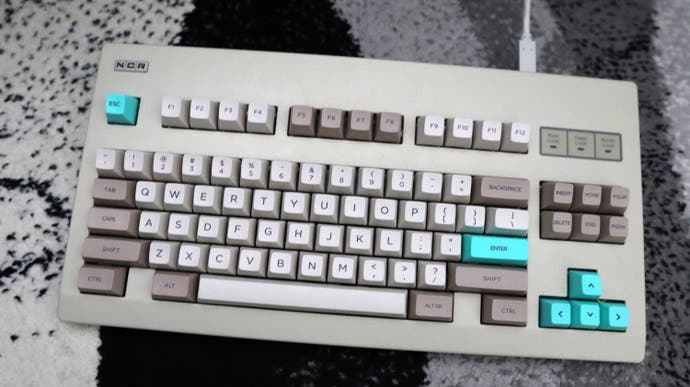
もちろん、より現代的な解釈として、有線接続用の USB-C ポートなどの利点が得られるほか、主要な機能の制御とさまざまなレイヤーでのプログラミングのための QMK および VIA の完全なサポートもあります。内部の PCB もホットスワップ可能で、3 ピンまたは 5 ピンであれば、ここに任意のスイッチを接続できます。ただし、これはシャーシ、PCB、スタビライザーだけであるため、自分で用意する必要があります。
MechBoards UK のとても親切な人たちがこれを送ってくれて、TTC Golden Blue を加えてスペックしてくれました。 G80-3000 が 1988 年に誕生した大音量キーボードのロマンティックな時代に傾いているため、クリック感のあるものでなければならないと感じました。これらは 37g のタクタイル スイッチで、総移動距離は 3.5 mm で、標準的な MX Blue よりも軽くてきびきびしています。あらゆる種類のコンテンツを書くのに非常に快適に使用できることがわかりました。また、より軽いスイッチなので、狂った人ならゲームに使用できるかもしれません。それにもかかわらず、ここのゴールデン ブルーは NCR-80 の雰囲気によく合い、付属の美しいベージュのキーキャップも外観を素晴らしく仕上げています。
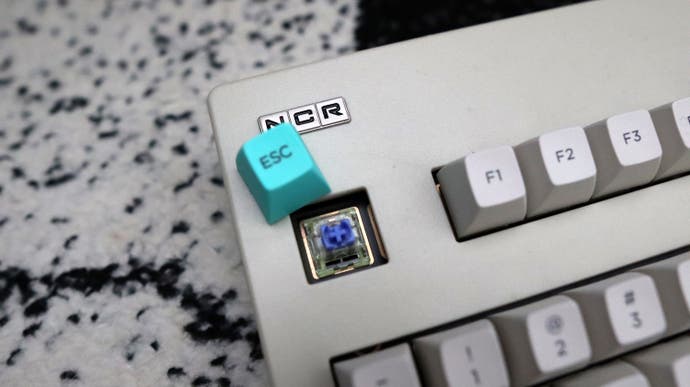
将来的には、どこかに保管してある MX ブラック クリア トップスの予備バッグとスイッチを交換するかもしれません。これらは、MX Ergo Clear コミュニティ MOD の適切なバージョンと MX Orange の復活を含む、最近の「公式」MX 再発行シリーズの一部です。クリアトップブラック、または親しみを込めてニクシーとして知られているものは、当初は 1980 年代にニクスドルフによって製造された一連のキーボード用に作られたもので、ここにはよく合うと思いますが、それはまた別の機会に。
NCR-80 の重要な点は、腕や脚にお金がかかるキットではないということです。オンラインでの価格は120ポンド/90ドルで、私がこれまでに出会った中で最も「手頃な」製品の1つであり、素晴らしいレトロな魅力と住みやすい機能、そして素晴らしいカスタマイズを素敵な全体的なパッケージに融合させたものです。手に入れることができれば、間違いなくお得です。
それで、これで完了です。過去数か月間テストを重ねたいくつかの小型フォームファクター キーボードに関する 4 つのレビュー。ウィルや私がテストする他の製品に関する推奨事項がある場合は、下のコメントに記入するか、Twitter @RBithrey または Bluesky @rbithrey.bsky.social で私にせがんでください。
***
Wildcard: NCR-80 R2 review: A DIY keyboard kit with retro sensibilities
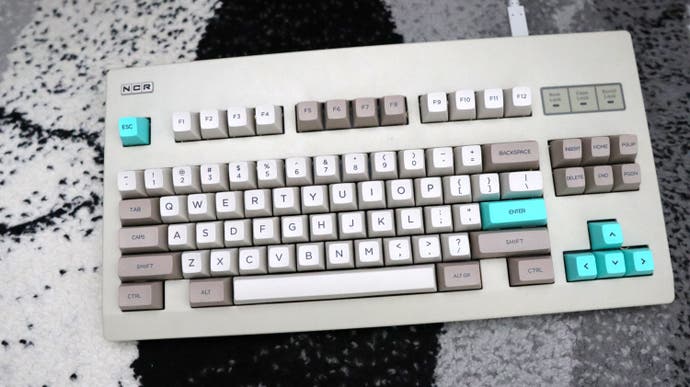
Buy:
I usually include a wildcard, or odder, choice in these roundups if you want to consider something that’s even more niche than the three choices above for small form factor keyboards. Allow me to introduce you to the NCR-80 R2.
On its own, it’s a TKL mechanical keyboard kit that you can purchase in barebones form with a PCB, stabilisers and case. There aren’t any switches or keycaps included, so you will need to purchase these separately.
In a world where mechanical keyboard design has become increasingly zany, bright and perhaps a bit wacky in some cases, the NCR-80 might seem a little boring. There is a good reason for this, though. This beige plastic case is designed to mimic the older Cherry G80 and G81-3000 models from the 1990s, and does so admirably. Having used my fair share of G80-3000s old and new (my very first mechanical ‘board was one with MX Blues), I can safely say that the NCR-80 nails it, and arguably improves on those late-era versions with an injection moulded plastic frame that suffers from no flex whatsoever. It also leans into the G80-3000’s look with bright green functioning lock lights in the top right corner, a lovely NCR logo in the opposing corner, and a totally-not Cherry label on the reverse.
Of course, as a more modern take, you get benefits such as a USB-C port for wired connectivity, while there is full QMK and VIA support for controlling key functionality and programming on different layers. The PCB inside is also hot-swappable, and you can have whichever switches you want in here, as long as they’re 3 or 5 pin. You will have to supply your own though, as this is just the chassis, PCB and stabilisers.
The very kind folks at MechBoards UK sent this over, and specced it out with some TTC Golden Blues. I felt like it had to be something clicky because it leans into the romanticised era of loud keyboards that the G80-3000 was born into back in 1988. These are 37g tactile switches with a total travel of 3.5mm, making them lighter and snappier than your standard MX Blues. I found them quite comfortable to use for writing up all sorts of content, and being a lighter switch, you could conceivably use them for gaming, if you’re a madman. Nonetheless, the Golden Blues in here fitted well with the feel of the NCR-80, as do the lovely beige keycaps provided, which round off the look wonderfully.

I may swap the switches out down the line for a spare bag of MX Black Clear Tops that I’ve got in storage somewhere. Those are part of the recent series of ‘official’ MX reissues that included proper versions of the MX Ergo Clear community mod, and the revival of the MX Orange. Clear Top Blacks, or Nixies as they’re affectionately known, were initially made for a run of keyboards produced by Nixdorf in the 1980s, so I feel they’d fit well in here, but that’s for another day.
The thing with the NCR-80 is is that it isn’t one of these kits that cost an arm and a leg. At £120/$90 online, it’s one of the more ‘affordable’ ones I’ve come across, and one that blends wonderful retro charm with livable features and fantastic customisation in a lovely overall package. If you can get one, it’s definitely worth it.
So, there you have it. Four reviews of some small form factor keyboards I’ve indulged in testing over the last few months. If you’ve got any recommendations for other products for Will or I to test, feel free to drop them in the comments below or pester me on Twitter @RBithrey or on Bluesky @rbithrey.bsky.social.
